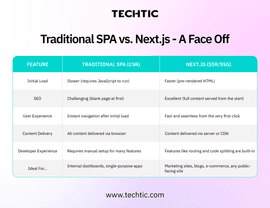Choosing Between Next.js and Traditional SPA Frameworks in 2025
Sector: Technology
Author: Nisarg Mehta
Date Published: 09/24/2025

Contents
Let’s be honest, you’re here because you’re facing a choice that’s more than just technical. On one side, you have the sleek, fast-loading, traditional SPAs. On the other, you’ve got modern heavyweights like Next.js, built for performance right out of the box. So, which way do you go? Do you build a beautiful, interactive app that feels awesome to use, or a website that search engines can actually find and understand?
The answer matters. It impacts how many customers find your site and whether they stick around once they get there. In this article, we’re going to walk through the differences and figure out the best path for you. It’s all about making a smart business decision, not just a tech one.
What is a Traditional SPA?
When you open a traditional Single-Page Application (SPA), the browser gets an empty page and a big packet of instructions, which is the JavaScript. It has to do all the work of building and showing the entire site. The upside is that once everything is loaded, moving from page to page feels instant. The whole thing is super seamless, no reloading, no waiting.
The big problem here is that first load. It’s a pain for both people and search engines. Even though modern search bots are getting smarter about running JavaScript, they don’t always fully index your content on the first visit, which could hurt your rankings. Plus, a blank screen can really frustrate users.
Enter the New Contender: Next.js
Next.js is a game-changer because it handles the painting for you. It builds the website’s pages before they’re even sent to the user’s browser, which solves the performance and SEO headaches of traditional SPAs. Next.js offers two main painting methods:
- Server-Side Rendering (SSR): With SSR, a complete painting is created on the server for each request. This ensures that the user receives a fully-formed masterpiece instantly, leading to immediate page display and optimal visibility for search engines.
- Static Site Generation (SSG): This is perfect for content that doesn’t change much, like a blog post. The pages are “painted” just once when the site is built and then served up as a finished piece. It’s an approach that leads to incredible loading speeds and works great with a Content Delivery Network (CDN).
Next.js vs Traditional SPA - Detailed Comparison
Let’s compare Next.js to traditional SPA on several key factors:
1. Content Delivery: A Strategic Comparison
So, how does a website just show up on your screen so fast? It’s all about how it’s built, you know? Let’s check out the three main ways a website gets its content from a server to you.
The Client-Side Rendering Process
In the CSR model, content delivery is a multi-step process. Initially, the browser receives an empty HTML shell. The burden of parsing and executing the JavaScript to construct the page rests entirely with the client’s device. While this architecture provides a highly interactive experience once the page is fully loaded, the initial latency can be detrimental to user experience and SEO.
The Power of Server-Side Rendering
The magic of SSR is that it does all the hard work on the kitchen side, that is, the server, so your pages arrive fully cooked and ready for visitors to enjoy. No staring at a blank screen. No second-guessing if the content’s coming. They see the good stuff fast, which means happier users and better signals for search engines. And let’s be real: happy visitors plus happy bots equals a win-win for your rankings.
Static Site Generation for Maximum Speed
For a website that’s all about speed, you’ve got Static Site Generation (SSG). This is like the ultimate pre-made meal. The website is completely built and saved as a bunch of static HTML files before anyone even visits. When a user asks for a page, a global network serves it up instantly. There’s no work to be done on the spot, so it’s a fantastic option for sites that don’t change much, like blogs or portfolios.
2. SEO and Performance: The True Impact
Your website’s speed isn’t a bonus; it’s a requirement. Google has been telling us for years that Core Web Vitals, how fast your content loads, how interactive your page is, and how stable the layout is, are a big deal.
With a Traditional SPA, you’re fighting an uphill battle. That initial blank page can hurt your SEO, and a slow first load can mess up your Core Web Vitals scores. That means fewer people finding you on Google and a higher chance of them leaving out of frustration.
With Next.js, you’re playing to win. Its ability to send a fully-rendered HTML page right from the start is exactly what search engines want to see. Your content gets indexed without a hitch, and your Core Web Vitals scores stay strong. The result: higher rankings and a much better user experience.
3. Performance & User Experience (UX)
With traditional SPAs, it can feel jarring at first. There’s often a blank screen during that initial wait, which can push visitors away. But once everything’s loaded, transitions between sections are lightning fast. The navigation feels snappy and smooth, almost like a native app.
Next.js really shines at delivering quick initial impressions. Because the content is ready up front, users see something right away, which creates a better first impression and helps keep people around. It also means web vital scores, like the First Contentful Paint, are typically much better.
4. Developer Productivity
Framework choice can make a big difference for your team’s workflow. SPAs usually need developers to set up and manage pieces like routing, state, and code splitting on their own. That can slow down updates and launches, especially for more complex projects. In contrast, Next.js tries to simplify things. It builds in support for tasks like routing and code splitting right out of the box, and features like instant previews when editing make coding more efficient.
Choosing a framework should be about fitting your business goals. SPAs can work well for internal tools or cases where SEO isn’t a big priority. For anything customer-facing where performance, SEO, and scalability matter, Next.js is a stronger candidate. Its toolkit helps teams build robust, fast sites, and its SEO features help sites stand out in search results, giving your business a real edge online.
5. Strategic Recommendations
Honestly, choosing the right web framework is something we’ve found to be way more than a pure tech call, it’s a strategic move that really needs to line up with what our business is trying to achieve. We’ve seen traditional Single Page Applications (SPAs) still work well, especially for simple internal tools or apps with just one goal where SEO isn’t a big deal.
But if you ask us, for businesses that rely on being found online, want something that scales without hassle, and really want to give users a smooth, enjoyable experience, Next.js tends to be the smarter choice. What we like about it is how it boosts performance, handles SEO like a pro, and makes development more streamlined.
Traditional SPA vs. Next.js - A Face Off

Top Apps That Are Using Next.js
Joining the Next.js community means you’re in good company with some real heavy hitters in tech.
- Take Hulu, for example, they rely on Next.js to keep their streaming smooth and responsive, ensuring viewers aren’t stuck waiting.
- Then there’s Netflix, which uses Next.js for its hiring portal. It might sound boring, but we all know how frustrating slow job applications can be.
- Twitch also taps into Next.js for parts of its streaming platform, making sure content loads quickly for fans worldwide.
- Even GitHub trusts Next.js for their marketing and documentation sites.
Seeing these names should make you realize: Next.js isn’t just a trend; it’s genuinely battle-tested and reliable, especially when massive audiences are involved.
The Best Tech Stack That Goes Along With Next.js
Sure, Next.js is like the engine under the hood, but what about the rest of the ride? From what we’ve seen, a balanced full stack really complements Next.js’s power:
- For databases, PostgreSQL wins on reliability, while MongoDB offers flexibility that’s hard to beat.
- Authentication feels complex, but tools like Firebase Auth or NextAuth.js simplify security and user login management. Honestly, it’s a relief to have that handled smoothly.
- When it comes to content management, headless CMS platforms like Sanity or Strapi make updates easy, even for non-developers. Trust us, this saves a ton of headaches.
- Deploying Next.js apps? Most folks we know swear by Vercel. Being the creators of Next.js, they offer integration that just clicks, automatic deploys, serverless functions, and zero fuss.
Conclusion
Next.js doesn’t merely check the necessary boxes of performance, scalability, and user experience, it does more by offering a future-proof platform that adjusts to the changing requirements of contemporary businesses with ease. From providing lightning-fast performance to supporting SEO-friendly architecture and providing unparalleled flexibility to developers, it prepares your product for long-term success in today’s highly competitive digital economy.
If we could provide one tip, it would be this: whenever performance, scalability, and growth for the long-term are your top concerns, Next.js should be high on your technology stack thoughts. Its capability to drive anything from MVPs to enterprise-level applications means it’s a reliable option for startups and brands alike.
At Techtic Solutions, our experts specialize in harnessing the full potential of Next.js to craft high-performing, scalable, and future-proof web applications. If you’re ready to bring your next app idea to life with the power of Next.js, connect with our team, we’ll help you turn your vision into a robust, market-leading product.
FAQs
Q: What is the main difference between Next.js and a traditional Single-Page Application (SPA)?
The biggest difference lies in how content is delivered. A traditional SPA uses Client-Side Rendering (CSR), where the browser downloads JavaScript and builds the page, often leading to slower first load times and SEO challenges. In contrast, Next.js supports Server-Side Rendering (SSR) and Static Site Generation (SSG), delivering fully pre-rendered pages that load faster and rank better in search engines.
Q: How does Next.js improve website performance compared to SPAs?
Next.js improves performance by pre-rendering pages, reducing the Time to First Paint (TTFP) and improving Core Web Vitals like Largest Contentful Paint (LCP) and First Input Delay (FID). With Static Site Generation (SSG) and CDN support, pages are served instantly, creating a smooth user experience from the first click.
Q: Next.js vs Traditional SPA: Which should I choose for my business?
- Choose Traditional SPA (CSR) → If you’re building an internal dashboard, single-purpose SaaS app, or non-SEO-critical tool.
- Choose Next.js (SSR/SSG) → If you need faster initial loads, SEO-friendly pages, high scalability, and a better user experience for customer-facing applications.
For most growth-driven businesses in 2025, Next.js is the smarter investment.
Q: Is Next.js good for mobile performance compared to SPAs?
Absolutely. Next.js optimizes mobile performance with faster Time-to-First-Byte (TTFB), image optimization, and responsive rendering. Unlike SPAs, which struggle with heavy JavaScript on slower devices, Next.js ensures lightweight, mobile-friendly experiences, improving both UX and Core Web Vitals on smartphones.



